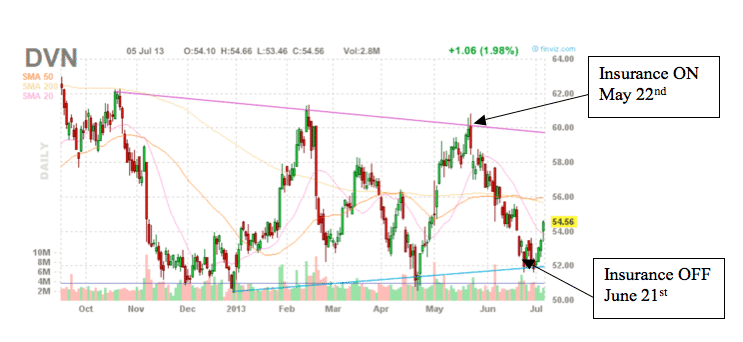One of the most important concepts in trading is risk management. And one of the best tools available for risk management is options, specifically the use
of options insurance strategies like the Collar trade.
You have probably discovered that risk management through diversification alone is insufficient. During major drops in the market most stocks and funds
decline also, leaving losses in their wake. Another popular method of risk management is the use of Stop Loss orders or Trailing Stop Loss orders. These
are designed to get you out of the trade with a (hopefully) manageable loss if your position gets in trouble. Using stop loss orders can leave you with a
loss, only to find that the stock is going back higher soon. In addition, Stop losses do not work well if a stock gaps down overnight, such as after an
earnings report. Just take a look at what happened to Lululemon (LULU) on earnings day in June.
Instead of using Stop loss orders, the best practice in risk management is to learn and master the Collar trade. A Collar trade is an options insurance
strategy on a stock or Exchange Traded Fund (ETF) or even on long term Call options known as LEAPS. In the Collar strategy, you own a stock or ETF for its
long term growth potential and/or dividends but choose to proactively get insurance in the short term through options. Common reasons to get insurance is
an upcoming volatile earnings event or a pullback in the market or your stock.
You get to choose how much insurance you need through the selection of two options.
(1) Selling to Open (STO) Call options (also known as Short Calls) gives you a small amount of insurance against the stock or ETF you own.
(2) Buying to Open (BTO) Put options (also known as Long puts) gives you a larger amount of insurance.
A collar trade therefore has three instruments: Stock + Short Call + Long Put. We have two options that act like insurance against the
stock. If the stock goes down and loses money, these two insurance options can make back most of that money.
Let’s examine this Collar trade concept through the recent price action in Devon energy (DVN).

I like to get insurance on my stocks when I believe they will fall in the short term. As a DVN stockowner I noticed on May 22nd that the stock
reached a known level of resistance near $60 and started to fall. The markets also started to fall that day after reaching an all time high. Based on that
and several other technical and fundamental reasons, I initiated a Collar strategy on DVN during this time by using Short Calls and Long Puts. Cash
received from Shorting calls usually pays for the Long puts so this insurance may be acquired without any cash outlay out of pocket!
As expected, the stock continued to decline until it reached a known level of support near $52 per share. During this time the stock lost money but both
the Short Calls and Long Puts made money back. By June 21st I closed both insurance options, now looking for DVN to find support and move
higher. The Long Puts made a profit of $4.09 per share and Short Calls made another $1.81 per share. As of July 5th the stock is down about $6
per share and my insurance made me about $6 per share. The important takeaway is that I reduced my cost basis in DVN stock forever by almost $6
per share during the last decline in share price.
This example illustrates the power of the Collar strategy and its advantages over using stop loss orders. If you bought the stock of DVN at the start of
2013 for around $54 you would have made no money on it, except the small dividend. If however you had been using the Collar strategy at appropriate times
you might have made some money on insurance during pullbacks in Feb, April and June. Just like the example above with the June pullback in DVN leaving
about $6 in insurance profit, the last three pullbacks could have made $6 x 3 = $18 in insurance profit. So the stock of DVN bought initially for $54 in
Jan 2013 would now have a much reduced cost basis of only $36. If you had imperfect timing and got less insurance profits, it would still be whole lot
better than never getting any insurance during pullbacks.
Collar trades offer protection during turbulent times for your stocks and ETF, even long term Call option trades. Make sure you have a detailed, repeatable
process for long term success in the markets, not just short term gains that evaporate with every pullback.
Charan Singh
OptionsANIMAL Instructor
Options Trading Resources
trading options course * practice options trading * stock market beginner * options trading course * trading classes * learn trade adjustment online * options trading community * learning to trade options


